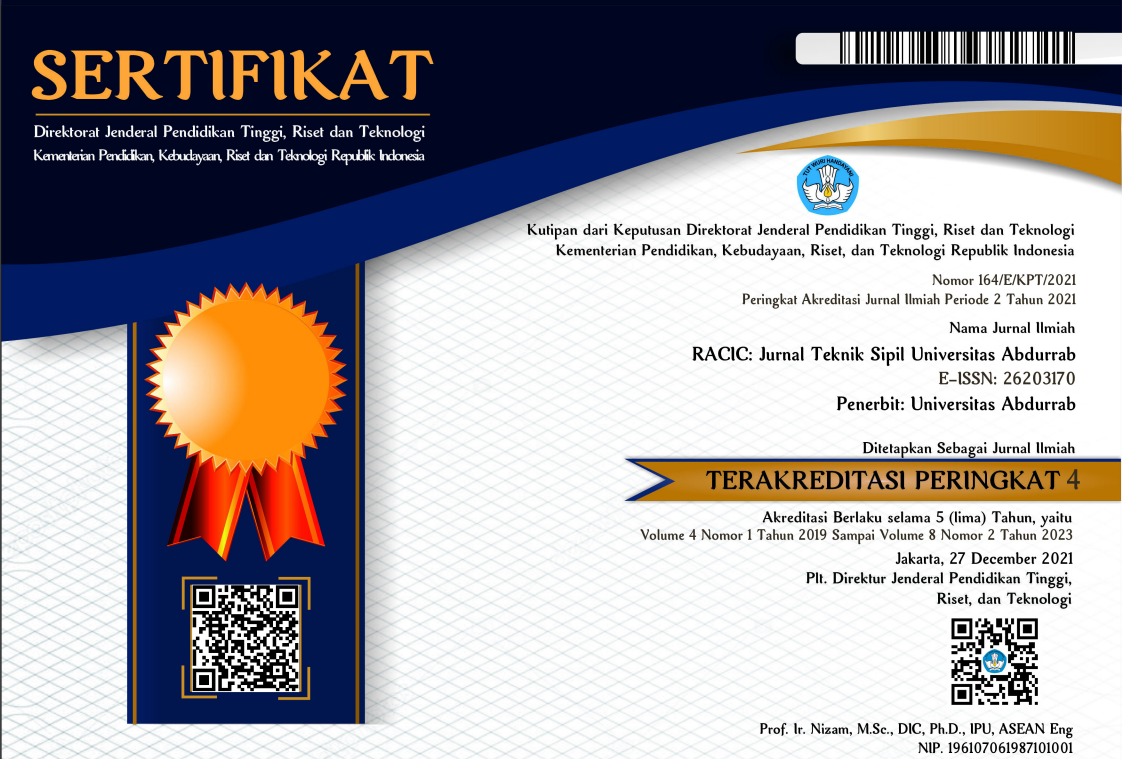PENINGKATAN KINERJA WADUK KEDUNGOMBO DENGAN MENGEMBALIKAN KAPASITAS TAMPUNGANNYA
DOI:
https://doi.org/10.36341/racic.v8i1.2817Keywords:
Sediment distributionAbstract
In every reservoir plan, the volume of dead storage provided is always taken into account to accommodate sediment entering the reservoir during the service life of the reservoir. Several studies on reservoir sedimentation show that 70% of reservoirs have sedimentation problems so the effective life of the reservoir will end before the design life is reached. The rate of sediment entering the reservoir will settle in the dead reservoir and the effective reservoir which will affect the performance of the reservoir. Therefore, it is necessary to take measures to improve the performance of the reservoir, one way is to restore its effective reservoir. Based on the results of bathymetry measurements of the Kedungombo Reservoir from 1989 to 2017, the sediment rate was 1.954 million m3/year. From the analysis of sediment distribution, the dead reservoir of the Kedungombo Reservoir at an elevation of +65.00 will be filled in 2089. The effective reservoir in 2089 at a normal water level of +90.00 of 527.71 million m3 has decreased by 106.89 million m3 from the initial effective reservoir is 634.6 million m3. To improve reservoir performance by restoring its effective reservoir, the Kedungombo Reservoir requires an elevation of the overflow or normal water level as high as 2.26 m with an inundation area of ​​48.72 million m2.
Keywords: Sediment Distribution, Storage Capacity, Reservoir Performance, Kedungombo Reservoir
Downloads
References
BBWS Pemali Juana. (2017). Rencana Tindak Darurat Bendungan Kedungombo.
Marhendi, T. (2013). Strategi Pengelolaan Sedimentasi Waduk. Techno, 14(2), 29–41.
Morris, G. L., & Fan, J. (2010). Reserviour Sedimentation Handbook.
Nur Harjanti, W., Darsono, S., & Suripin. (2020). Analisis Distribusi Sedimen pada Waduk Raknamo dengan Metode Empiris Pengurangan Luas. Jurnal Teknik: Media Pengembangan Ilmu Dan Aplikasi Teknik, 19(01), 1–09. http://creativecommons.org/licenses/by/4.0/
Samatha Putra, D., Sapto Atmojo, P., & Ari Wulandari, D. (2020). Optimalisasi Kegiatan Pemeliharaan Pada Waduk Gondang, Kabupaten Karanganyar Terhadap Sedimentasi. Briliant: Jurnal Riset Dan Konseptual, 5(2), 394. https://doi.org/10.28926/briliant.v5i2.447
Strand, R. I., & Pemberton, E. L. (1982). Reservoir sedimentation technical guidelines for Bureau of Reclamation. US Bureau of Reclamation, Denver, Colorado, 48.
Suroso, Ruslin Anwar M, & M, C. R. (2007). Studi Pengaruh Sedimentasi Kali Brantas Terhadap Kapasitas dan Usia Rencana Waduk Sutami Malang. Jurnal Rekayasa Sipil, 3(September), 119–122.
Sutrisno, J., Sanim, B., Saefuddin, A., & Sitorus, S. R. P. (2011). Prediksi erosi dan sedimentasi di Sub Daerah Aliran Sungai Keduang Kabupaten Wonogiri. Media Konservasi, 16(2), 78–86.
Tukaram, S., PT, N., & MR, G. (2016). Comparison of Area Reduction Method and Area Increment Method for Reservoir Sedimentation Distribution - Case Study Ujjani Dam. International Journal of Research in Advanced Engineering and Technology, 2(3), 108–111.
UNESCO International Sediment Initiative. (2011). Sediment Issues & Sediment Management in Large River Basins Interim Case Study Synthesis Report. Report, 88.
Zefri, R., Wulandari, D. A., & Suripin. (2022). Penerapan HEC-HMS untuk Pendugaan Erosi dan Sedimentasi Metode MUSLE pada Waduk Paselloreng di Kabupaten Wajo. 6(2), 103–116.
Downloads
Published
Issue
Section
License
1. Copyright of all journal manuscripts is held by the RACIC : Rab Construction Research
2. Formal legal provisions to access digital articles of electronic journal are subject to the provision of the Creative Commons Attribution-ShareAlike license (CC BY-NC-SA), which means that RACIC : Rab Construction Research is rightful to keep, transfer media/format, manage in the form of databases, maintain, and publish articles.
3. Published manuscripts both printed and electronic are open access for educational, research, and library purposes. Additionally, the editorial board is not responsible for any violations of copyright law.
licensed under a Creative Commons Attribution-ShareAlike 4.0 International License.





